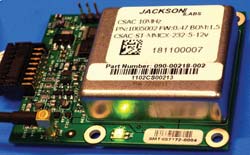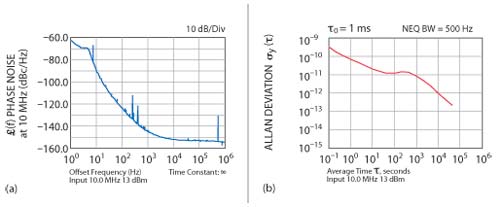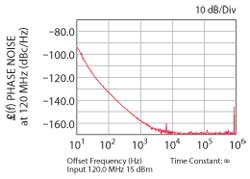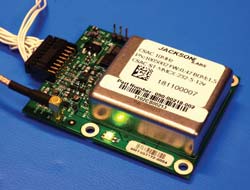
The recent advent of commercially available Chip Scale Atomic Clocks (CSAC) marked a paradigm shift in the timing and frequency industry. CSACs are able to replace traditional Rubidium, Cesium, Crystal and GPS Disciplined references while providing significant performance increases as well as size and weight improvements. These improvements are so drastic that entirely new applications can now be realized that were impossible to achieve with legacy technology. CSACs enable products to be realized that run from small Lithium batteries for days to weeks, and some applications, such as underwater exploration, can achieve years of operation running on battery power. CSAC battery power-sources can be small enough to fit into the size of a cell phone while having a frequency accuracy and stability comparable to legacy Rubidium atomic frequency standards with days to weeks of operating time.
Radio, cell phone, Satellite and radar applications require oscillators with very low phase noise, and more recently, extremely high frequency accuracy, frequency stability and timing accuracy. This accuracy is measured in parts per trillion (ppt) rather than the traditional parts per million (ppm) achievable with legacy crystal oscillators as are typically used in low-power applications. The availability of high performance GPS receivers and the first commercially-available miniature CSAC have enabled a one-million-to-one leap in performance over traditional crystal oscillators (XO) while at the same time reducing size and power consumption over legacy atomic oscillators by orders of magnitude. By combining GPS signals with the first commercially available CSAC oscillator made by Symmetricom Inc. and a purpose-designed low-phase-noise Crystal Filter Oscillator, Jackson Labs Technologies was able to introduce the first commercially available CSAC GPS Disciplined oscillator (CSAC GPSDO), shown in Figure 1.

Fig. 1 10 MHz CSAC GPSDO module using a Cesium vapor cell.
Changing the Status Quo
Traditional frequency references use Quartz crystal oscillators to generate frequencies that are typically accurate and stable to ppm when used in XOs, or tens of parts per billion (ppb) in higher-cost TCXO or OCXO oscillators. OCXOs typically dissipate several Watts of power, and require 5 to 30 minutes or more to warm up to stabilize. The best SC-cut, double-oven crystal oscillators (DOCXO) can still exhibit drift of several ppb after power on and over temperature, especially if a frequency calibration is done shortly after power on at a time when the crystal is still retracing. This can result in 50 microseconds or more of timing drift per day, with the drift rate typically increasing day over day in these types of oscillators. The CSAC GPSDO can achieve sub 1 microsecond drift per day (~1.16 × 10-11 drift over 24 hours) in a typical laboratory environment, and will maintain sub ppb accuracy over weeks and months of operation. Typical legacy Rubidium Atomic references which can be replaced by the CSAC GPSDO have a height of 1.5 inches or more, dissipate 15 to 20 W of power at cold temperatures, weigh over 1 lb and take 5 to 10 minutes to warm up at cold temperatures. They are also limited to operation below 70°C on their baseplate and require that the user supplies external frequency calibration or disciplining circuitry and software.
GPS: The (almost) Perfect Celestial Reference
To counter phase and frequency drift in crystal oscillators, 1 pulse per second (PPS) aligned to Coordinated Universal Time (UTC) with nanosecond accuracies can be generated by GPS receivers independent of location anywhere around the world. They are typically used in GPSDOs to continuously calibrate the internal quartz crystal oscillator to achieve frequency and phase lock of the local oscillator to the Cesium atomic clocks used to generate the UTC reference at the U.S. Naval Observatory (UTC USNO). The GPS satellites are thus used to distribute the USNO 10 MHz frequency standard with phase accuracies typically better than one cycle at 10 MHz over short and long time periods anywhere around the world. Generating an accurate frequency is called frequency syntonization, while maintaining phase coherence to UTC is called synchronization. The best free running Cesium frequency reference cannot maintain nanosecond-level synchronization to UTC over days or weeks without calibration via GPS signals. This is due to the fact that nanosecond phase accuracy over long periods of time requires performance measured in fractional ppt, far exceeding commercially available Cesium and Rubidium reference performance. While GPSDO systems work well when GPS signals are available and are not being jammed or spoofed, they typically require a long warm-up and stabilization time (measured in hours) and do not preserve phase and frequency accuracy without active and constant GPS reception. Operation without the benefit of GPS calibration is called holdover, or flywheel mode, and this holdover operation is where the CSAC oscillator excels when compared to crystal oscillators.
Cesium Atoms Save the Day
Atomic clocks have been available commercially to generate stable and accurate frequencies since at least 1958. These clocks generally use Cesium or Rubidium atoms that are excited by an external energy source and are generally interrogated by a microwave servo loop. Contrary to popular belief, non-radioactive isotopes are used in atomic clocks. This microwave servo loop controls an external reference crystal and steers the crystal onto frequency. In the CSAC, a Cesium vapor cell is excited from a VCEL Laser source. The VCEL is modulated at ~4.6 GHz to produce a complementary pair of sidebands separated by the extremely accurate and stable Cesium ground state hyperfine transition frequency of 9,192,631,770 Hz. A servo loop measures the light output of the Cesium vapor cell and controls the frequency of a low power 10 MHz TCXO and the VCEL microwave modulation to achieve frequency lock to the Cesium vapor cell. The CSAC oscillator then generates a highly accurate and stable 10 MHz signal. This process happens with less than 120 mW of power consumption in the CSAC. The process of locking the TCXO to the Cesium resonance is typically achieved in less than 110 seconds after power on. The Cesium vapor cell itself is only 1 cm3, and allows the overall height of the CSAC GPSDO product to be less than 0.7 inches. This size compares very favorably to industry standard DOCXO and Rubidium based units that typically have heights of 1 inch or more preventing these to be used to retrofit legacy equipment such as VME racks.

Figure 2 10 MHz CSAC GPSDO phase noise (a) and Allan Deviation (b) plots.
CSAC GPSDO – A Real World Product
The business end of the Jackson Labs Technologies CSAC GPSDO shown in Figure 1 provides various isolated low phase noise 5 MHz CMOS and 10 MHz sine wave outputs and a UTC-synchronized 1 PPS CMOS output. An additional, low phase noise post filter reduces the phase noise of the unit by up to 13 dB and removes spurs. An RS-232 and a USB port allow the generation of NMEA-0183 and SCPI control sentences, with system status and alarms. Power consumption is typically 0.8 to 1.4 W maximum depending on the configuration, and the unit can be powered from a +5 to +36 VDC source. A typical phase noise and Allan Deviation plot of the CSAC GPSDO is shown in Figure 2. The Allan Deviation plot of the CSAC GPSDO shows stabilities of better than 1/10 ppb (0.1 × 10-9) for averaging times of one second or longer, and better than one ppt (1 × 10-12) for averaging times of 10k seconds or longer when locked to GPS.
The CSAC GPSDO provides the following typical advantages when compared to legacy Rubidium, Cesium or crystal-based products. These characteristics were heretofore not simultaneously achievable in a single product:
- Low power consumption of 0.8 to 1.4 W which does not vary significantly over temperature
- No warm-up power peaks that OCXO based products would exhibit
- Ultra-short warm-up of < 60 s typically, 110 s maximum to 0.5 ppb frequency accuracy
- Atomic long-term frequency accuracy and stability
- Wide operating temperature range of -40º to +85ºC
- Less than 0.2 ppb per g per axis sensitivity
- Very low height and weight of less than 0.7 inches and < 64 g (< 2.25 oz)
- Cesium vapor cell does not suffer from Cesium depletion allowing 100,000 hours MTBF
- Phase noise of -124 dBc/Hz at 100
- Hz, -153 dBc/Hz at 100 kHz
- UTC phase and frequency synchronized and syntonized operation
- No ITAR or HazMat shipping restrictions

Fig. 3 120 MHz CSAC GPSDO phase noise plot.
The CSAC GPSDO fast warm-up and low power operation allows for very fast in-field deployment of battery operated devices while maintaining phase synchronization to UTC after only a 2 to 3 minute calibration to GPS. This is useful in applications such as manpack radios and jammers, underwater exploration, unmanned aerial vehicles (UAV), as well as mobile satellite and radar stations.
120 MHz Radar Reference Implementation
The 10 MHz output of the CSAC GPSDO can be upconverted to higher frequencies such as L-Band radar frequencies, typically requiring additional phase noise filtering. To improve the phase noise for up-conversion applications, a 100/120 MHz companion filter oscillator was designed that connects to the CSAC GPSDO seamlessly. It maintains the CSAC GPSDO frequency accuracy and stability while improving phase noise by more than 40 dB. The filter oscillator was designed to be used in high vibration environments such as UAVs or helicopters and has internal vibration damping. The unit is 1.75" × 2.8" × 3" and includes a vibration damped and an extremely low-g sensitivity crystal with a typical sensitivity of less than 5 × 10-11 per g per axis at 100 Hz. Figure 3 depicts the static phase noise plot of the 120 MHz filter oscillator, showing that the typical noise floor of 174 dBc/Hz is below that of the instrument that measures it. The plot was generated by beating two identical 120 MHz units against each other, which results in a plot that displays the phase noise 3 dB higher than actual. A -3 dB correction factor was not applied to Figure 3.

Fig. 4 Small form factor CSAC GPSDO for dismounted (man-pack) applications.
Flavors Galore
Jackson Labs Technologies will shortly be offering additional versions of the CSAC GPSDO in various form-factors optimized for different applications, including an ultra-low-power version for battery-powered, long-term underwater exploration with less than 50 mW average power consumption, a ruggedized small footprint unit that is 2" 32.5" 30.7" in size (see Figure 4), and a unit with ovenized crystal cleanup post filter for ADEV performance of better than 5 × 10-12 from 1 second averaging intervals.
Jackson Labs Technologies Inc.,
Los Gatos, CA
(408) 354-7888,
info@jackson-labs.com
